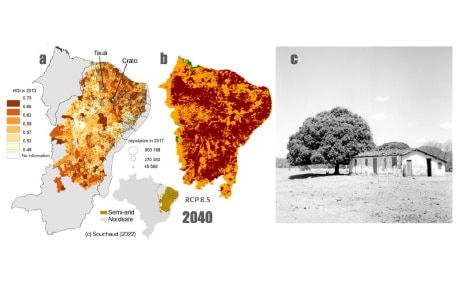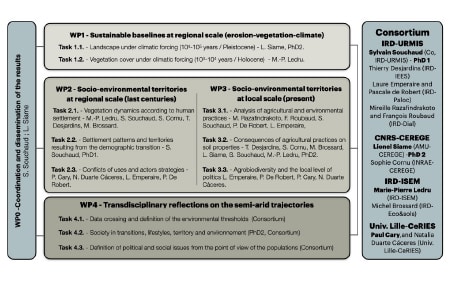ANR TASAB
The project TASAB is interested in the problems of the global crisis, understood as a crisis of social and environmental systems.
Its objective is to explore the mutual relations between society and environment in the semi-arid region of the Brazilian Northeast by considering the Anthropocene from two complementary approaches: firstly, a diagnostic aspect, i.e. documentation of the mechanisms of global change, and secondly, a more prospective approach, i.e. one that would initiate a reflection on the ecological transition in this semi-arid Brazilian region.
To this end, we have defined a territorial approach, marked by multidisciplinarity (soil and life sciences, geomorphology, sociology, economics) which aims to relate the dynamics of biomes and social organisation while combining spatial and temporal scales of observation, establishing pre-anthropic frameworks, studying generational dynamics and taking an interest in biographical paths.
We target the soil component that we have located as central in the soil-vegetation-climate nexus, making the interface in this territorial approach of living areas.
We also have a study component that concerns family farms in a very arid commune in Ceará that are partly organised for organic cotton production by a cooperative that raises farmers' awareness of soil management and health. The consortium for this project brings together researchers from IRD, INRAE and the universities of Lille and Aix-Marseille. It includes researchers who have been involved in IRD activities in Brazil for many years (S. Souchaud, URMIS; L. Siame and S. Cornu, CEREGE; M.-P. Ledru, ISEM; M. Brossard, Eco&Sols; T. Desjardins, IEES; M. Razafindrakoto and F. Roubaud, LEDA; L. Emperaire and P. De Robert, PALOC; P. Cary, CeRIES).
The project is structured around four work packages. WP1 consists in determining the natural levels, i.e. the reference levels of the functioning of the environment, from the pre-anthropic era to the last millennia, excluding the last two centuries. Work packages 2 and 3 aim at defining socio-environmental territories, identified both at regional (WP2) and local (WP3) scales and taking into account the determinants of social dynamics (settlement, lifestyle, agricultural practices) and their consequences on the environment (vegetation and soils). WP4 is devoted to the identification of potential trajectories by quantifying their level of degradation and by defining the political and social stakes from the point of view of the populations.
Faced with the challenges of the Anthropocene, TASAB proposes an approach integrating environmental and social sciences. Its originality lies in the combination of approaches that mobilise several spatial and temporal scales in order to restore the complexity of the socio-environmental dynamics at work in one of the most populated semi-arid regions in the world. TASAB will make it possible to examine the vulnerabilities and resilience of this territory in order to better understand the challenges and strategies for adaptation.
2023-2027: ANR TASAB
CEREGE lead :
Lionel Siame
What can a territory do in the face of the global anthropocene crisis? Socio-environmental dynamics in the Brazilian semi-arid
Partners URMIS, ISEM, Eco&Sols, IEES, LEDA, PALOC, CeRIES



